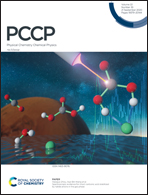Correlation between structural and optical characteristics of conjugated copolymers differing by a Si bridge atom
Abstract
In this study, we investigate two copolymers as electron donors in photovoltaic devices, PFO-DBT (poly[2,7-(9,9-dioctylfluorene)-alt-4,7-bis(thiophen-2-yl)benzo-2,1,3-thiadiazole]) and its analogue with Si, PSiF-DBT (poly[2,7-(9,9-dioctyl-dibenzosilole)-alt-4,7-bis(thiophen-2-yl)benzo-2,1,3-thiadiazole]). The results discussed here are related to the influence of heavy atoms on the electrical and morphological properties of the devices. Charge transfer dynamics in the polymeric films were evaluated using the core–hole clock method. Besides that, using density functional theory (DFT) and time-dependent DFT (TD-DFT) methods, we investigate the electronic structure and charge transfer properties of the two systems. The charge transfer rates were estimated in the framework of the semiclassical Marcus/Hush theory. We found that the better stacking between the polymer chains for PSiF-DBT provides higher solar absorption capacity in regions of higher wavelengths and faster hole transfer rates. We also obtain a faster electron transfer rate at the PSiF-DBT/C60 interface compared to the PFO-DBT/C60 interface that is mainly related to the difference in the driving force between the two systems. These features help to explain why the organic photovoltaic devices using PSiF-DBT as the active layer exhibited a higher performance compared to devices using PFO-DBT. Here, we show that our results are able to provide important insights about the parameters that can influence the photovoltaic performance of the devices.



 Please wait while we load your content...
Please wait while we load your content...